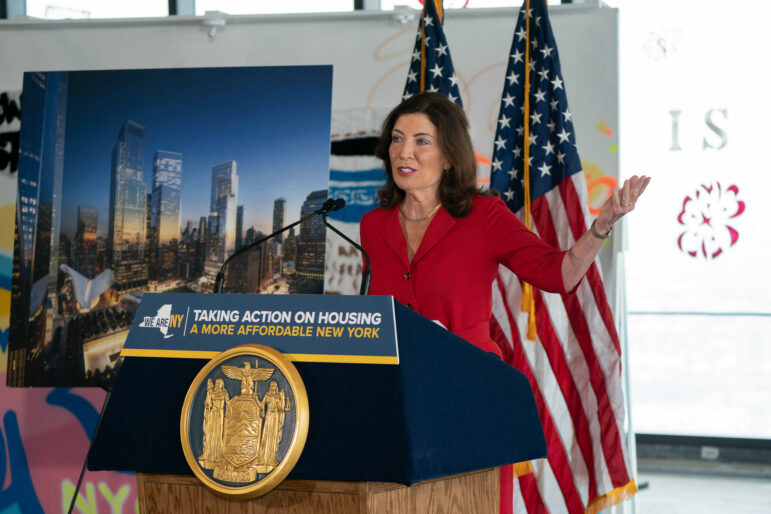The 400 income-restricted units at 5WTC, the only residential project planned for the World Trade Center site, mark an increase from prior proposals but fall short of the 100 percent affordability some advocates had sought.

Don Pollard/ Office of governor Kathy Hochul
Gov. Hochul announces next steps for 5WTC in Lower Manhattan.Construction will start next year on 1,200 apartments on public land in Lower Manhattan, the site of the former Deutsche Bank building damaged during the 9/11 terrorist attacks, Gov. Kathy Hochul announced Thursday.
The 5WTC project, led by a development team including Silverstein Properties and Brookfield Properties, will have 400 apartments designated as affordable—a third of the total. The set-aside of income-restricted units is an increase from prior site plans, though far below the 100 percent affordability some advocates had demanded.
“I say that 1,200 units, one third of them affordable, is far better than no outcome at all,” Hochul said at a press conference at nearby 3 World Trade Center. “So we teamed up, took a bold approach, powered through the obstacles, and again brought this back from the grave.”
Of the affordable units, 80 will be offered to people who lived or worked in Lower Manhattan during 9/11, according to the governor’s office. The land is owned by the Port Authority of New York and New Jersey and will have the only apartments at the World Trade Center site.
Thursday’s announcement followed a vote that morning by the state’s Public Authorities Control Board (PACB), allowing the project to advance and approving $60 million in state funding, as well as $5 million from the Battery Park City Authority.
A planned 5WTC vote had been removed from the agenda at last month’s PACB meeting, according to state Senator Brian Kavanagh, who represents the area.
At that time, Kavanagh said, he was dissatisfied with the proposed affordability levels—360 apartments for households earning between 60 and 110 percent of the area median income (AMI), or $72,060 to $132,110 for a family of three.
“We made it clear that it wasn’t really acceptable as proposed at that stage,” Kavanagh told City Limits. The new $65 million in funding “preserves deep affordability while going from 300 [affordable] units to 400 units,” he added, referencing the site’s original proposal for the number of affordable homes.
The affordability advanced Thursday ranges from 40 percent to 120 percent AMI—$50,840 for a family of three on the low end, and $152,520 on the high end.
The governor’s office did not provide a precise breakdown, but Kavanagh said the range is 84 apartments each at 40, 65* and 80 percent AMI, plus 74 units each at 100 and 120 percent AMI. The potential for deeper affordability is baked into an accompanying PACB resolution, Kavanagh added, if more funding materializes in the coming months.
“Basically if additional money becomes available, anytime between now and next April, the developer and the state agencies said that they’ll negotiate and provide additional affordability,” he said.
The 5WTC site is located in Council District 1, represented by Councilmember Christopher Marte. An analysis by the New York Housing Conference shows that the area started construction on 1,177 affordable apartments between 2014 and 2021, ranking 22 among the 51 districts.
Rachel Fee, executive director of the New York Housing Conference, said the 5WTC deal will bring much needed affordable housing to the neighborhood.
“The deal they struck is a really balanced one,” she said. “It’s both the engineering, the labor, all of that is a scale we don’t typically see for affordable housing.”
Reactions were mixed from members of the Coalition for a 100% Affordable 5WTC.
Todd Fine, founder of the historical preservation-focused Washington Street Advocacy Group, said Thursday that he has not been active in the coalition’s day-to-day work for the past year, having become frustrated with a lack of transparency from Empire State Development, a state economic development entity involved in the plan.
By scaling down the project to rein in construction costs, the state could have negotiated more deeply-affordable apartments overall, he said Thursday, citing a feasibility study the coalition had funded. Fine called this a “missed opportunity.”
Vittoria Fariello, a local district leader and coalition member who attended Thursday’s press conference, called the deal a “good start”—particularly the preference for 9/11 survivors—though the AMI set-asides north of 80 percent were “a surprise, for sure.”
Fariello expressed hope that more funding will be secured in the coming months, to deepen affordability in a desirable area. The site is on top of a public transportation hub, with access to parks, jobs and high-performing schools.
“So many of my neighbors have already left because they can’t afford to live here anymore,” she said.
*Correction: An earlier version of this story misstated the project’s second AMI band. The correct AMI is 65.








